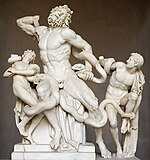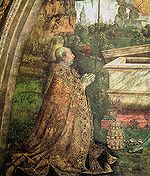The Borgia Apartments are a suite of rooms in the Apostolic Palace in the Vatican, adapted for personal use by Pope Alexander VI (Rodrigo de Borja). In the late 15th century, he commissioned the Italian painter Bernardino di Betto (Pinturicchio) and his studio to decorate them with frescoes.The paintings and frescoes, which were executed between 1492 and 1494, drew on a complex iconographic program that used themes from medieval encyclopedias, adding an eschatological layer of meaning and celebrating the supposedly divine origins of the Borgias. Five of the six apartments include frescoes painted in the vault. The upper register of the vaults contain paintings, while the lower registers are decorated with tapestries and gold. Recent cleaning of Pinturicchio's fresco The Resurrection has revealed a scene believed to be the earliest known European depiction of Native Americans, painted just two years after Christopher Columbus returned from the New World.The Borgia Apartments includes six rooms: Room of the Sibyls, Room of the Creed, Room of the Liberal Arts, Room of the Saints, Room of Mysteries, and Room of Pontiffs. The Room of Sibyls and the Room of Creed include frescoes of the Old Testament prophets and sibyls. These room also pay homage to the planets. In the Room of Liberal Arts, Pinturicchio has represented the liberal arts as female figures through his frescoes in the vault. The Room of Saints consists of frescoes detailing the lives of seven notable saints, including Barbara, Catherine, Anthony, Paul, Susanna, and Elizabeth. Pinturicchio's last room, the Room of Mysteries, contains frescoes with New Testament subject matter, including the Nativity, Ascension, Adoration of the Magi, and other scenes.The Room of the Pontiffs was erected before all the other buildings, between 1277 and 1280. Built between 1447 and 1455, the Room of the Liberal Arts, Saints, and Mysteries were referred to as "secret rooms" by Pope Alexander VI's master of ceremonies, Johannes Burchard. As of 2019, the suite was open to tourists.










